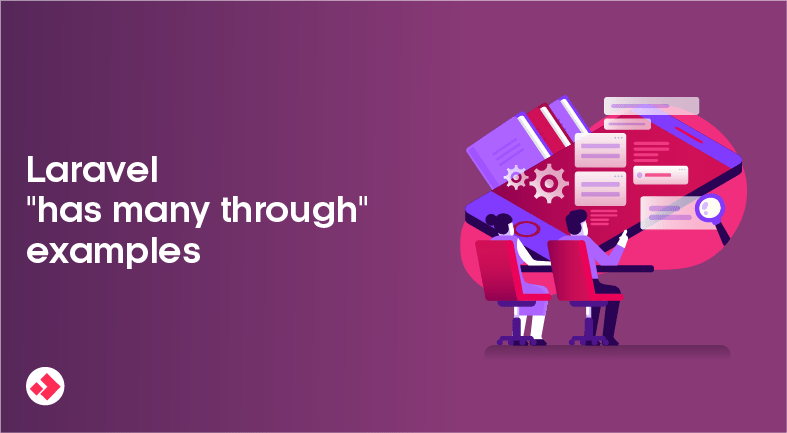Table of Contents In Laravel, many-to-many relationships are established using an intermediate table that holds foreign keys from the related
Exploring the Powerful “Has Many Through” Relationship in Laravel: 3 Real-Life Examples
- Muhammad Waqas
- May 15, 2023
- 5:03 am
- No Comments
Table of Contents

In Laravel, relationships are a crucial aspect of database design and querying. One of the most powerful relationships is the “has many through” relationship, which allows you to retrieve records that belong to a particular model through a third model. This relationship is particularly useful when dealing with complex data structures and allows you to retrieve related data in a single query.
In this blog post, we will explore the “has many through” relationship in Laravel and provide three real-life examples of its usage, along with the code and explanation.
Understanding Has Many Through Relationship
Before we dive into the examples, let’s take a quick look at the “has many through” relationship in Laravel. This relationship is defined by three models: a source model, an intermediate model, and a destination model. The source model has a “has many” relationship with the intermediate model, and the intermediate model has a “has many” relationship with the destination model. The “has many through” relationship allows you to retrieve all the related records of the destination model through the intermediate model.
Here’s an example to make it more clear. Let’s say we have three models: User, Role, and Permission. A User can have multiple Roles, and each Role can have multiple Permissions. We can define the “has many through” relationship as follows:
class User extends Model
{
public function permissions()
{
return $this->hasManyThrough(Permission::class, Role::class);
}
}
In this example, we’re defining a permissions method on the User model, which uses the hasManyThrough method to retrieve all the Permission records associated with a User through their Role records.
Example 1: E-commerce Application
Let’s take the example of an e-commerce application where we have three models: User, Order, and Product. A User can have multiple Orders, and each Order can have multiple Products. We can use the “has many through” relationship to retrieve all the Product records associated with a User through their Order records.
class User extends Model
{
public function products()
{
return $this->hasManyThrough(Product::class, Order::class);
}
}
In this example, we’re defining a products method on the User model, which uses the hasManyThrough method to retrieve all the Product records associated with a User through their Order records. We can eager load the products relationship as follows:
$users = User::with('products')->get();
This will retrieve all the User records along with their associated Product records, and it will only execute two queries.
Example 2: Social Media Application
Let’s take the example of a social media application where we have three models: User, Post, and Tag. A User can have multiple Posts, and each Post can have multiple Tags. We can use the “has many through” relationship to retrieve all the Tag records associated with a User through their Post records.
class User extends Model
{
public function tags()
{
return $this->hasManyThrough(Tag::class, Post::class);
}
}
In this example, we’re defining a tags method on the User model, which uses the hasManyThrough method to retrieve all the Tag records associated with a User through their Post records. We can eager load the tags relationship as follows:
$users = User::with('tags')->get();
This will retrieve all the User records along with their associated Tag records, and it will only execute two queries.
Example 3: Employee Management System
Let’s take the example of an employee management system where we have three models: Department, Employee, and Project. A Department can have multiple Employees, and each Employee can work on multiple Projects. We can use the “has many through” relationship to retrieve all the Project records associated with a Department through their Employee records.
class Department extends Model
{
public function projects()
{
return $this->hasManyThrough(Project::class, Employee::class);
}
}
In this example, we’re defining a projects method on the Department model, which uses the hasManyThrough method to retrieve all the Project records associated with a Department through their Employee records. We can eager load the projects relationship as follows:
$departments = Department::with('projects')->get();
This will retrieve all the Department records along with their associated Project records, and it will only execute two queries.
Conclusion
In conclusion, the “has many through” relationship is a powerful feature in Laravel that allows you to retrieve related records through a third model. This relationship can be used in a variety of real-life scenarios, such as e-commerce applications, social media applications, and employee management systems. By using eager loading, you can retrieve all the related records in a single query, which can significantly improve the performance of your application.
Popular Post
Table of Contents Introduction: Laravel is a PHP framework that has become quite popular in recent years. One of the
Table of Contents In Laravel, models are the backbone of the application. They act as a bridge between the database
Table of Contents Laravel is a popular PHP framework that is widely used for web application development. One of the

An experienced Code Debugger with a strong track record of identifying and resolving complex software issues. I aim to contribute my analytical skills and expertise in debugging tools to ensure efficient and reliable software operations and deliver high-quality software products that meet customer requirements.
If you found this content valuable, please show your support by following me on Medium, LinkedIn, Twitter and GitHub. Your support will motivate me to create more informative content in the future. Don’t forget to give a clap or share this blog with others if you found it helpful!
